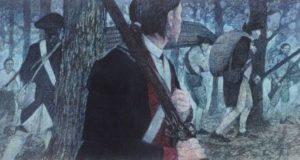Andebit et beaqui corendit, ut quostes esciendion re dit ad et prae parion es quia quas alibus sam, omnim faciden ducipidiat arum autem nobis enis es voat

20. Kingsbury Pocket Park: Moving a City
Burgoyne’s progress slowed once on land, but Baron Riedesel had a plan to help the army move more quickly.
Listen to the Turning Point Trail Site 20 Audio Narration:

The further Burgoyne and his army got from his supply base in Canada, the more difficult things became for his soldiers. The army was like a moving city, with more than ten thousand residents, all of whom needed food, drink, medical supplies, and more. It was relatively easy to load heavy cargo by boat on Lake Champlain, but that only worked up to Whitehall. Some of the materials went by way of Lake George, but Burgoyne had greater difficulty getting supplies to his troops traveling from Whitehall.
If Burgoyne had followed his original plan and taken the whole army by way of Lake George, then the troops and cargo would be traveling together by ships. By splitting up transport, Burgoyne was separated from much of his supplies, making logistics much more challenging. The men grew weary from the heavy labor of cutting a road, and as the distance grew, their supplies began to dwindle. He was moving too slow to advance on the Rebels.
Baron Riedesel had been stationed around Hubbardton, Vermont, when he saw the difficulties that Burgoyne was facing. He took it upon himself to communicate a plan. He informed Burgoyne that the country around Hubbardton was “full of the best horses” that could be used to “carry the necessary baggage of the officers, the tents, ammunition, artillery and provisions.” He recommended buying them from the settlers.
But Riedesel also had an ulterior motive. His regiments of mounted infantrymen, known as Dragoons, were without horses. Britain’s King George III would not pay to transport their horses from Europe, but agreed that he would provide them if the circumstances became necessary. Riedesel believed the conditions now warranted it and suggested that Burgoyne send the Dragoons, plus 30 soldiers from each regiment under a good staff officer, toward the Connecticut River to gather the horses they needed.
It would be several weeks before Burgoyne would act on Riedesel’s plan. Perhaps Burgoyne did not agree with Riedesel’s assessment of his situation at that time, but by the end of July 1777 things would be more dire. In the meantime, Riedesel left Hubbardton for Fort Ann to take up the rear of the army, while General Fraser made his way to Fort Edward with the advance.
Travel Tools
Just before the village of Kingsbury, you’ll see a triangular green with a white parish house and Baptist church on your right. Pull in here, park, and listen to track 20. Settlers were quick to settle the fertile and abundant lands of this region after the Revolutionary War was over. The Kingsbury Baptist church was constructed about 1790. The historic burying grounds are across the street.
CLICK TO ADVANCE PAGE TO SITE TWENTY-ONE
First-Hand Accounts
“When the regiments have a sufficient number of pack horses collected, and when the transportation of the artillery is safely provided for, then your excellency can send out detachments at pleasure; keep a check upon the main body of the enemy; and thus keep the inhabitants in subjection- yea, even break up their militia, and procure the necessary support for the army. You can, also, extend or contract the army as you see fit, and thus freely operate independently of the bateaux and a thousand other contingencies.” —General Riedesel to General Burgoyne, Skenesborough July 22, 1777


